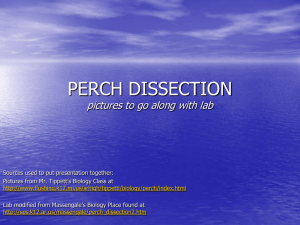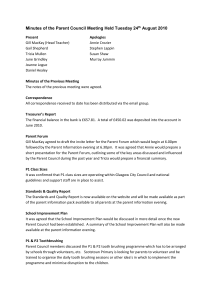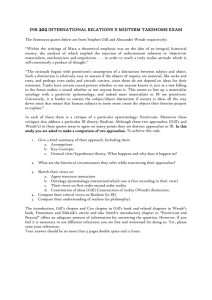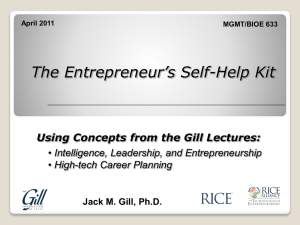Learning Log – X-Alliance Trio - Jurassic Coast Teaching Schools
advertisement
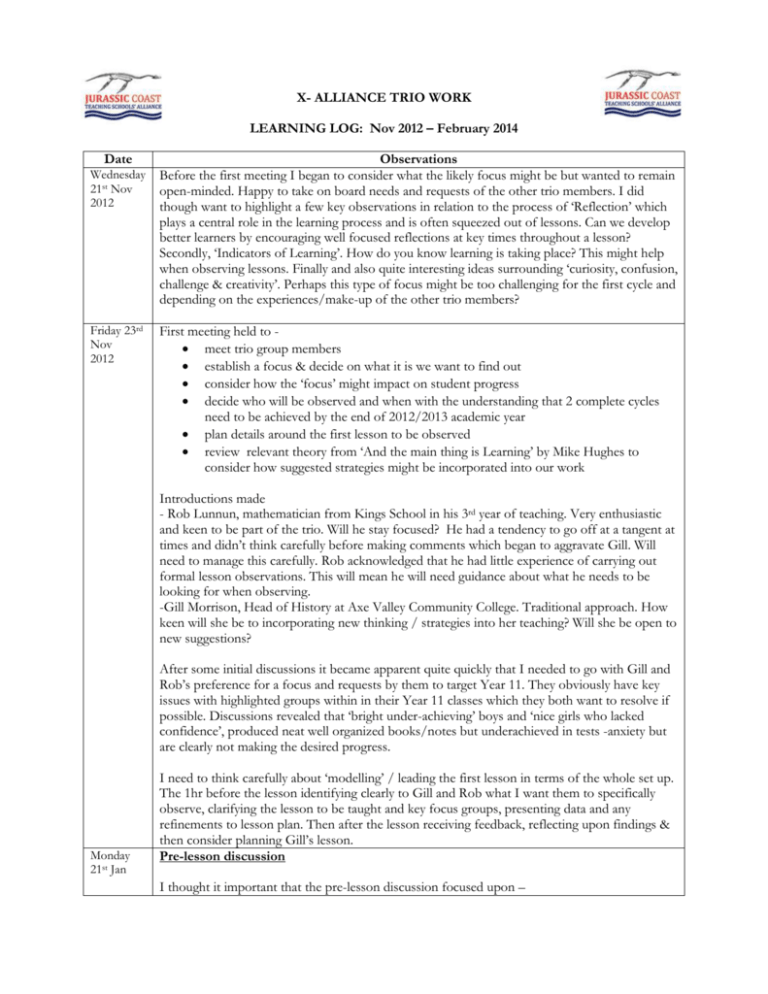
X- ALLIANCE TRIO WORK LEARNING LOG: Nov 2012 – February 2014 Date Wednesday 21st Nov 2012 Friday 23rd Nov 2012 Observations Before the first meeting I began to consider what the likely focus might be but wanted to remain open-minded. Happy to take on board needs and requests of the other trio members. I did though want to highlight a few key observations in relation to the process of ‘Reflection’ which plays a central role in the learning process and is often squeezed out of lessons. Can we develop better learners by encouraging well focused reflections at key times throughout a lesson? Secondly, ‘Indicators of Learning’. How do you know learning is taking place? This might help when observing lessons. Finally and also quite interesting ideas surrounding ‘curiosity, confusion, challenge & creativity’. Perhaps this type of focus might be too challenging for the first cycle and depending on the experiences/make-up of the other trio members? First meeting held to meet trio group members establish a focus & decide on what it is we want to find out consider how the ‘focus’ might impact on student progress decide who will be observed and when with the understanding that 2 complete cycles need to be achieved by the end of 2012/2013 academic year plan details around the first lesson to be observed review relevant theory from ‘And the main thing is Learning’ by Mike Hughes to consider how suggested strategies might be incorporated into our work Introductions made - Rob Lunnun, mathematician from Kings School in his 3rd year of teaching. Very enthusiastic and keen to be part of the trio. Will he stay focused? He had a tendency to go off at a tangent at times and didn’t think carefully before making comments which began to aggravate Gill. Will need to manage this carefully. Rob acknowledged that he had little experience of carrying out formal lesson observations. This will mean he will need guidance about what he needs to be looking for when observing. -Gill Morrison, Head of History at Axe Valley Community College. Traditional approach. How keen will she be to incorporating new thinking / strategies into her teaching? Will she be open to new suggestions? After some initial discussions it became apparent quite quickly that I needed to go with Gill and Rob’s preference for a focus and requests by them to target Year 11. They obviously have key issues with highlighted groups within in their Year 11 classes which they both want to resolve if possible. Discussions revealed that ‘bright under-achieving’ boys and ‘nice girls who lacked confidence’, produced neat well organized books/notes but underachieved in tests -anxiety but are clearly not making the desired progress. Monday 21st Jan I need to think carefully about ‘modelling’ / leading the first lesson in terms of the whole set up. The 1hr before the lesson identifying clearly to Gill and Rob what I want them to specifically observe, clarifying the lesson to be taught and key focus groups, presenting data and any refinements to lesson plan. Then after the lesson receiving feedback, reflecting upon findings & then consider planning Gill’s lesson. Pre-lesson discussion I thought it important that the pre-lesson discussion focused upon – the two main groups (‘bright’ / lazy boys & conscientious girls who underachieve in tests) who were the intended focus. The strategies to be used by myself to find out which might be most effective with these groups. to outline of the lesson, the previous lesson and the next lesson To help Rob and Gill I produced group & individual student data (target groups), photographs & notes on student learning characteristics / behaviour traits. a lesson plan all resources to be used in lesson. Post lesson discussion Starter activity (activity 1) tested out prior learning. It clearly identified students who struggled with recalling key information or hadn’t understood aspects from previous lesson. It identified for student’s areas for further revision. For the main episodes of the lesson I selected working pairs/trios very carefully and appointed leaders who had clear instructions. Both Gill and Rob highlighted that ‘accountability’ was a strong driver to ensure students completed the set tasks. Students didn’t want to let others in their group down (each student had to deliver subject content to 2 other students) or be made to look foolish (because they hadn’t bothered or engaged with the initial task and so couldn’t fulfill their role in the following task). Boys were challenged and girls had peer mentors / buddies who they felt comfortable asking if they didn’t understand or wanted clarification. Homework culture / expectations clearly embedded with this group. Collaborative learning (‘active learning’ task) clearly effective. Level of engagement remained high throughout lesson for both focus groups. Rob completed ‘level of engagement’ graph which clearly evidenced this outcome. By changing working groups for activities 2&3 students were kept on their toes & engaged. Rob commented that boys benefitted from being able to move around class. It was noted that students worked with teacher and were highly motivated. Peer assessment task highlighted areas of subject knowledge strength & weakness. Homework task was set to test out level of understanding which will lead on to deep learning activities in the next lesson. Thought from today To enable us to identify what really works is very much dependant on quality & detail of observation and consequently that of feedback given by observers. Perhaps I expected greater attention to detail? Planning for Gill’s lesson (6th Feb @ Axe Valley) Focus groups to remain the same Strategies to be explored Peer assessment How element of competition can promote engagement by boys It was agreed that Rob would observe the focus group of boys & Sharron the girls. Wednesday Pre-lesson discussion at The Axe Valley School led by Gill 6th Feb The pre-lesson discussion focused upon – the two main groups (‘bright’ / lazy boys & conscientious girls who underachieve in tests) who were the intended focus. the strategies to be used by Gill to find out which might be most effective with these groups. an outline of the intended lesson Post lesson discussion Observations: This was an active learning lesson and as such was accessible to all students present. The competition element worked well. One of the target boys, performed poorly in the first round because his preparation was not thorough enough. In the second round he raised his game and showed much better knowledge and explanation skills. Quiet girls showed their competitive side and were keen to win their one-to-one debates Modeling the debate was effective for getting students to generate relevant success criteria. Some students were spotted consulting this during their debates as a support to helping them win. The fact that the debate was not a written task appealed to the target boys and weaker writers. Students were able to see the link between the thought processes needed to win a debate and the success criteria in exams. Understanding the chemistry of your group is key to success with this kind of activity. Working with 2 articulate girls put Cameron under enough pressure that he felt motivated to argue well. He showed satisfaction at being pronounced winner of the second debate. Abe was the other target boy present. He did a lot of preparation for the task and his worksheet was full of evidence. However the debate element of the lesson was not a success. In his case the chemistry of his trio did not do him any favours – Gill put him with 2 people who are very strong verbally and he was unable to show flexibility. Nonetheless, Gill noted that his output in terms of writing and understanding information was better than usual. Rob will be teaching the next lesson – on 6th March. He will be looking at developing the strategy of competition through a carousel of activities. Wednesday 6th March Pre-lesson discussion at The King’s School.Ottery led by Rob Focus – Are specified groups within this Yr 11 class making the expected level of progress? To find out - What strategies are effective with specified ‘groups’ of students? Focus groups to be - underachieving ‘bright’ boys & girls who produce neat / organized work but underperform in tests. Specific students discussed in depth in terms of ability, levels of effort, aspirations and personal characteristics. Strategies – peer assessment (of slightly different tasks worked on at the same time), positive competition, energy from teacher to encourage fast pace, lots of different activities to keep students engaged, opportunity at the end for individual assessment of all students’ learning. Rob discussed / provided Sharron and Gill with group & individual student data , seating plan & notes on student learning characteristics & traits. a skeleton lesson plan outlining learning objectives, resources and activities to be used, and specific strategies to be implemented. all resources to be used in lesson and relevant solutions for different tasks/activities.. Post-lesson discussion Starter activity re-capped previous grade B knowledge quickly and effectively, whilst prompting students to assimilate new knowledge with minimal teacher input. All students recalled past learning very well, with lots finishing all set work very fast, and all completing at least the expected minimum and a bit more. Technique of working “until set number of people have finished” helped to motivate students through positive competition. The lesson then progressed to introducing the concept of a general, numerically undefined vector. Starter activity served to link very well to this new learning through making numerical and geometrical links explicit. The fact that the class is bright and interested greatly facilitated this. A whole class example was then discussed at pace, with students indicating confidence with the work. A small amount of time was then given over to students to practice (2/3 mins), during which time no overriding issues arose so learning progressed to the main planned activity. Sharron and Gill noted the clear willingness of all members of the group to work whilst mostly all enjoying themselves. Preparation of whole class resources helped to do this quickly which allowed pace to be maintained. Main activity required students to come up with their own vectors for 2 different shapes, with the idea being to swap and peer asses after a set period of time. Stopwatch was used effectively to keep to set timings, which were adhered to very accurately by all students (with some moving onto extension activity within this time). The openness of the task appealed to students, as did the large number of possibilities which ensured that even the brightest students had enough to keep them busy. Students seemed to engage well when both doing and then assessing the task, with the vast majority achieving 100%, and any errors were clearly identified and misunderstandings understood. Sharron and Gill commented that the competition, whilst appealing greatly to the boys, did not seem to hinder the girls’ progress (indeed, identified girls were happy to share that they had made errors in front of the whole class). Most students remained very motivated and completed “extension” activity which linked together various different elements of the lesson. Such was the pace of the lesson, I was able to do another short activity looking at working backwards, which served to motivate good discussion and push learning to the next level. The final activity required students to answer 10 questions individually, providing the teacher with the opportunity to assess the individual learning of all students, which proved to be positive with all students gaining at least 8 (and most 9 or 10) out of 10. Sharron and Gill commented on the fact the pace of the lesson was important for keeping students interested and working well. Peer assessment was effective and well received by students. They observed that students were clearly motivated to do well, and targeted strategies served really well to motivate reluctant boys in particular, many of whom enjoyed one of the best lessons I had ever seen them produce. They also highlighted the importance of knowing all members of a group really well, and being able to engage with students on a personal as well as academic level. It was also evident that simply being able to dedicate more time to the lesson was of huge benefit in terms of the engagement and learning achieved. Planning for Sharron’s lesson (Monday 18th March @ Woodroffe) Second focus decided – “Deep Thinking”. Exploring techniques which lead to students reconstructing/manipulating/reformulating learning into new/different/innovate forms. Tuesday 19th March Rob unable to attend due to transport issues. Gill & I continued anyway. Pre-lesson discussion Briefly discussed focus for lesson Focus – to demonstrate & develop understanding by asking students to convert information into a different form (source: And the main thing is Learning – Mike Hughes. P.156 – 157) To find out - What strategies are effective with different ‘groups’ of students? Focus groups to be - those students aspiring to achieve beyond target grade. Sharron discussed / provided Gill with group & individual student data & notes on student learning characteristics & traits. a lesson plan all resources to be used in lesson. Post-lesson discussion Starter activities (Word search & Crossword) tested out prior learning. It clearly identified students who were confident in their subject knowledge & those who struggled with recalling key words / key information. It identified for the students their strengths/weaknesses. Homework task set will encourage independent thinking and develop understanding. Students appeared to think it would be fun to create a challenge for another student in the group as a starter activity. For the main episode working pairs/trios were selected very carefully. Three levels of challenge worked well with additional tasks added at intervals to deepen understanding. Teacher worked at developing student resilience as some students too quick to ask for help instead of grappling with the problem for longer and trying to reach their own conclusion. Collaborative visual learning (‘active learning’ task – creating a mind map) was clearly effective for the vast majority of class. Level of engagement remained high throughout lesson for ‘top’ focus group and all but 1 student in ‘middle’ focus group. Gill noted that Toby & Sam struggled with size of the task and for them it needed to be given in smaller chunks to enable them to gain initial ‘success’ before moving on. It was noted that the low ability students made particular progress. Students enjoyed the series of tasks and gained confidence in their knowledge and understanding of the topic. The majority of students indicated at the end of the lesson that they felt their learning had progressed. Again, the importance of selecting the right students to work with each other was an important factor. Planning for Gill’s lesson (Wednesday 17th April @ Axe Valley) New strategies to be explored – students to have a choice of 3 activities which will involve changing information to a different form Wednesday 17th April Monday 20th May Pre-lesson discussion at The King’s School.Ottery led by Rob Rob wanted to answer the question, “How do I know they’ve really got it?” Techniques to promote deep thinking through activities which require students to reformulate/restructure understanding in a creative way. Rob chose a matching activity (% increase and decrease) as a starter to recap prior knowledge. This promoted challenge. For the main activity students worked in pairs and were challenged to make up questions for another pair to answer but also work out the answers to their own work. tIf any errors were found then students were encouraged to jot it/them down on a post-it note for discussion later. Through practice and repletion students consolidated knowledge and were able to work through processes they were less confident with. Students enjoyed peer assessment task and trying to find mistakes. Extension tasks set for those who worked very quickly. Post lesson discussion Overall Rob felt this was a positive lesson in which students demonstrated good understanding and knowledge of content and required techniques. High level of challenge was appropriate even for less able students, who coped well with the complexity of the task. Main activity allowed students to extend their understanding, and certainly resulted in higher attainment. Some struggled with openness of tasks in terms of staying focused and motivated, and the level of freedom afforded was too much for some students who took advantage of this, resulting in some low level disruption. Rob had tried out same type of activity previously which he said had helped a lot. End of school year. 22.1.2014 Commencement of 3rd cycle. Pre-lesson discussion at The Woodroffe School led by Sharron Group briefly discussed focus Focus – Challenging learners across the ability groups at AS level. To find out - What strategies effectively enable all learners to make progress? Focus group to be – Yr 12 mixed ability class Sharron discussed / provided Rob and Gill with group & individual student data & notes on student learning characteristics & traits. a lesson plan all resources to be used in lesson. Post-lesson discussion Starter activity (activity 1) tested out what had been learnt from homework task. It clearly identified students who were confident in their subject knowledge & had watched footage of American Football. It allowed everyone to make contributions based on what they were watching and further develop subject knowledge. Class engaged quickly with this task and enjoyed the discussion. Homework culture / expectations clearly embedded with this group. Students were then required to use the provided images to discuss the origins and nature of the game of American football (activity 2). This continued to build and extend their subject knowledge and required the students to draw on information gleaned in homework research task. The mixed ability pairs were carefully selected. This information was then shared with the rest of the class. Students were able to build on one another’s responses and allowed teacher key opportunities for extended questioning. Some students needed prompting from teacher to record key information. The pairings were then changed for the remainder of the lesson. Students worked in same ability pair. Sources were introduced to develop and extend the students understanding of the reasons for the violent nature of the game and then the key aspects of commercialism in American Football. The collaborative learning tasks (‘active learning’ task) were effective. Level of engagement remained high throughout lesson for majority of the group. Although the lowest ability pair then struggled with the last task which required the students to write a markscheme for an exam question linked to the current topic. They found it difficult to make the link between “How can I use what I have just learnt to help me successfully complete this task?” Perhaps the markscheme could have been shown at start of task so the lower ability pair had an idea of what expected outcome should look like? They needed further small steps to help them make the link. It was noted that all students worked with teacher, were highly motivated and enjoyed the topic area. They understood the need for detail and depth in their subject knowledge to enable them to access their target grades. A research homework task was set to further look at the nature of American sport – The Win Ethic, the big 4 American sports & the American Dream Gill’s lesson next, Wednesday 12th Feb @ Axe Valley Rob’s lesson March 4th @ King’s 4th March After both Gill and Rob’s lessons I felt they both played safe, there was no ‘risk taking’, maybe something for the future? The key strategies employed by both did have the desired effect and progress was made by the ‘target pairs’ within the observed lessons but could this be sustained? Would they continue to look for new ideas and test them out in the future now that this trio group has come to an end? After Rob’s lesson the trio discussed the positive experience which everyone had gained from the collaborative process. Gill was intending to set up a trio working group within her History department and base it on the format we have developed over the course of the last year and a half. Rob commented that he had grown in confidence, felt supported and had gained hugely from focused observations of other colleagues. It was clearly important that I taught the very first lesson and modeled the pre & post lesson discussions as both commented that this had set the standard and the tone for the whole process. It was felt by all that we hoped that in the future we would get the chance to work together again. It might be very interesting to work together in a year or two’s time? It has been an exciting and much valued CPD opportunity which we would probably not have been given if it had not been for the Alliance. I have certainly enjoyed the challenge of this experience and the opportunity to develop my skills leading a trio which included colleagues from other schools, teaching different subjects and at very different stages in their teaching career. It demonstrates that if the trio is well managed and the focus is clearly on learning then it can be very successful.

